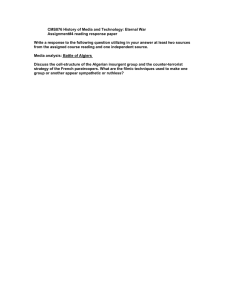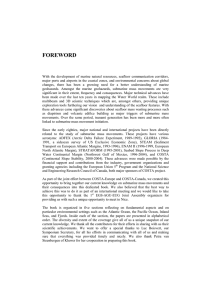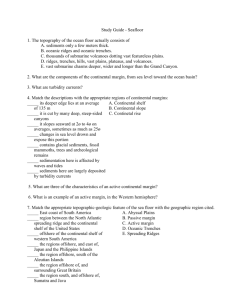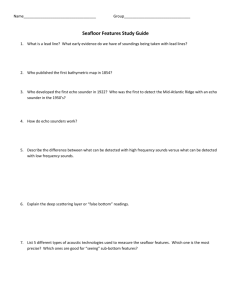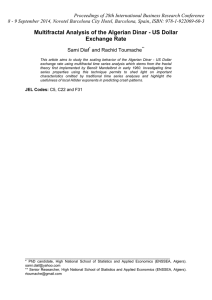Submarine Landslides Along the Algerian Potential Link with Tectonic Structures
advertisement
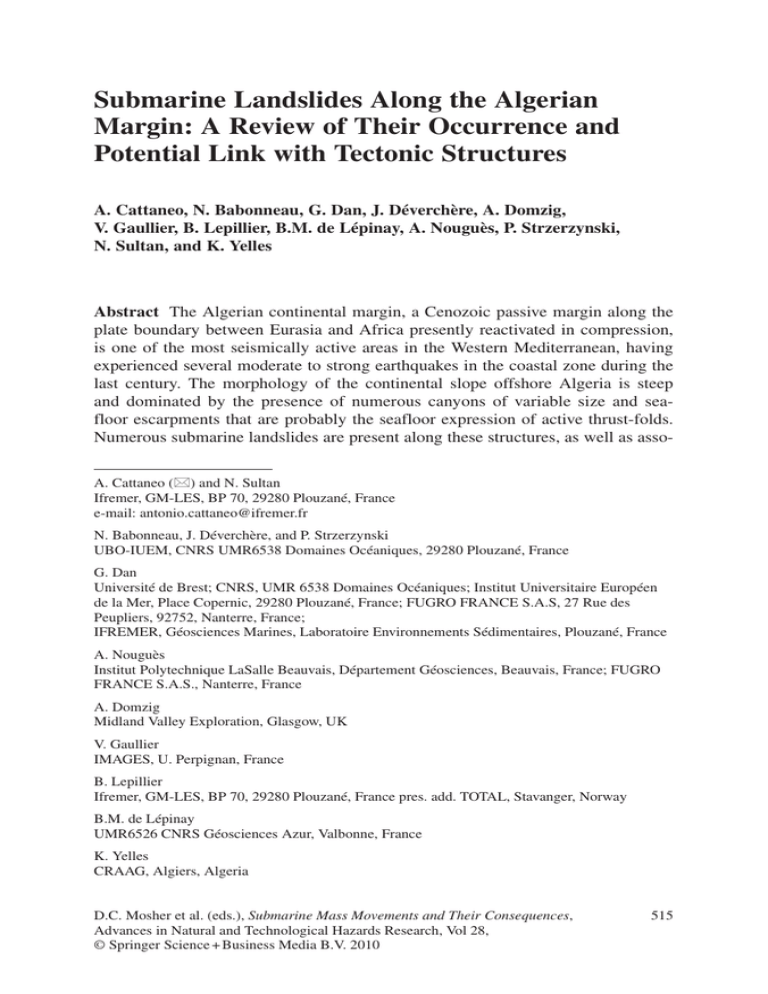
Submarine Landslides Along the Algerian Margin: A Review of Their Occurrence and Potential Link with Tectonic Structures A. Cattaneo, N. Babonneau, G. Dan, J. Déverchère, A. Domzig, V. Gaullier, B. Lepillier, B.M. de Lépinay, A. Nouguès, P. Strzerzynski, N. Sultan, and K. Yelles Abstract The Algerian continental margin, a Cenozoic passive margin along the plate boundary between Eurasia and Africa presently reactivated in compression, is one of the most seismically active areas in the Western Mediterranean, having experienced several moderate to strong earthquakes in the coastal zone during the last century. The morphology of the continental slope offshore Algeria is steep and dominated by the presence of numerous canyons of variable size and seafloor escarpments that are probably the seafloor expression of active thrust-folds. Numerous submarine landslides are present along these structures, as well as assoA. Cattaneo () and N. Sultan Ifremer, GM-LES, BP 70, 29280 Plouzané, France e-mail: antonio.cattaneo@ifremer.fr N. Babonneau, J. Déverchère, and P. Strzerzynski UBO-IUEM, CNRS UMR6538 Domaines Océaniques, 29280 Plouzané, France G. Dan Université de Brest; CNRS, UMR 6538 Domaines Océaniques; Institut Universitaire Européen de la Mer, Place Copernic, 29280 Plouzané, France; FUGRO FRANCE S.A.S, 27 Rue des Peupliers, 92752, Nanterre, France; IFREMER, Géosciences Marines, Laboratoire Environnements Sédimentaires, Plouzané, France A. Nouguès Institut Polytechnique LaSalle Beauvais, Département Géosciences, Beauvais, France; FUGRO FRANCE S.A.S., Nanterre, France A. Domzig Midland Valley Exploration, Glasgow, UK V. Gaullier IMAGES, U. Perpignan, France B. Lepillier Ifremer, GM-LES, BP 70, 29280 Plouzané, France pres. add. TOTAL, Stavanger, Norway B.M. de Lépinay UMR6526 CNRS Géosciences Azur, Valbonne, France K. Yelles CRAAG, Algiers, Algeria D.C. Mosher et al. (eds.), Submarine Mass Movements and Their Consequences, Advances in Natural and Technological Hazards Research, Vol 28, © Springer Science + Business Media B.V. 2010 515 516 A. Cattaneo et al. ciated with salt diapirs in the abyssal plain. Submarine landslides are expressed by seafloor scars (usually of small size) and subsurface or buried acoustically chaotic/ transparent units interpreted as mass transport deposits (MTD). Compared with the most recent (superficial) small size of slide scars, buried MTDs seem to be of larger size, possibly suggesting a change in the functioning of gravity-driven processes in the margin throughout the Plio-Quaternary. Keywords Submarine landslides • multibeam • seafloor morphology • seismic stratigraphy • Algerian margin 1 Introduction The Algerian margin is a Cenozoic passive margin along the plate boundary between Eurasia and Africa, presently reactivated in compression. The deformation is expressed by ESE-WNW-aligned seafloor escarpements that represent the seafloor expression of thrust-folds (Déverchère et al. 2005; Domzig et al. 2006). These structures are associated with crustal shortening and moderate to large earthquakes (Nocquet and Calais 2004). The Algerian continental margin is one of the most seismically active areas in the Western Mediterranean, having experienced several moderate to strong earthquakes and tsunamis during the last century. The most violent instrumentally recorded earthquake occurred on October 10, 1980 in El Asnam (currently Chlef), and reached a magnitude (Ms) of 7.3 (El Robrini et al. 1985). More recently, on May 21, 2003 an earthquake with a magnitude (Ms) of 6.9 struck the city of Boumerdès, on the coast near Algiers, and generated significant gravity flows recognized by numerous submarine cable breaks offshore (Ayadi et al. 2003). Numerous submarine landslides are present both at the seafloor and in the subsurface. Over three sectors marked in Fig. 1a as zones NC1, NC2 and NC3 they have been characterized as transparent or chaotic echofacies (Domzig et al. 2009; Dan et al. in press). In some cases, individual small-scale submarine landslides with a well-defined morphology were studied in detail (Dan et al. 2008; Dan et al. this volume; Nouguès et al., this volume). The aim of this paper is to provide an overview of the distribution of submarine landslides along the Algerian margin and to discuss their impact on the morphology of the Algerian margin with preliminary considerations on the relationships between the location of distinct morphologic sectors, tectonic structures, earthquake epicenters and submarine landslides. 2 Data and Methods This paper summarizes data from four campaigns led from 2003 to 2007 in the Algerian offshore area: MARADJA 1 and 2 (2003 and 2005, R/V Le Suroît), PRISMA (2004, R/V Marion Dufresne), PRISME (2007, R/V L’Atalante). The dataset includes multibeam bathymetry, seafloor imagery (SAR side scan sonar), Fig. 1 Areas of multibeam bathymetry with navigation of seismic lines (above) and morphologic interpretation of the continental slope (below) Submarine Landslides Along the Algerian Margin 517 518 A. Cattaneo et al. high resolution seismic reflection profiles (multichannel and CHIRP sonar; Fig. 1a). The multibeam bathymetric dataset was acquired in 2003 and 2005 with a Kongsberg Simrad EM300 multibeam system operating at 32-kHz with a horizontal resolution of 15 × 35 m at 1,000 m depth and a vertical accuracy of 2 to 10 m (central and lateral beams, respectively). Seafloor samples and in situ tests, cited from recent publications based on the same dataset, are not discussed extensively in this paper. Submarine landslides were identified visually as follows: (1) seafloor morphology evidence of slide scars and/or of convex-up slide deposits with distinct backscatter signature; (2) seismic reflection evidence of acoustically transparent units interpreted as MTD either buried or at the seafloor. In the maps presented in this article, slide scars are outlined in maps with lines drawn along the zone of maximum slope angle, while the acoustically-transparent deposits (MTDs) are identified by their areal extent. 3 Margin Physiography The Algerian margin occupies the southern edge of the Western Mediterranean between 1°W and 8°E in longitude for a total coastal length of 1,280 km. It faces the Alboran and the Algero-Provençal basins. The Algerian margin is in general quite steep, with narrow plains and a few large embayments (Oran, Arzew, Algiers, Bejaia, Skikda, Annaba), where the largest Algerian cities grew (Fig. 1a, b). The Algerian continental shelf is relatively narrow (5 to 10 km wide on average). It is virtually inexistant (< 2 km) in areas offshore Dellys and Tenes, where the mountain ranges are close to the coastline, while it reaches up to 40 km in width offshore the main embayments. The continental shelf break is comprised between 100 and 200 m water depth and is indented where submarine canyon heads cut into the shelf. The continental slope is in general steep (often >10°, locally up to 20°) cut by numerous canyons and includes some ponded slope basins (Déverchère et al. 2005). It extends from 100–200 to 2,300–2,500 m, with a very variable width commonly comprised between 8 and 20 km, with an exceptions offshore Annaba, where it attains 35 km of width. On the continental slope offshore central Algeria there are several abrupt escarpments (e.g., S2 in Fig. 2) that are probably the surface expression of active tectonic structures (Déverchère et al. 2005; Domzig et al. 2006; Kherroubi et al. 2009). The main sediment transport systems (including submarine canyons, submarine valleys with channel-levee complexes) are outlined in Fig. 1b. Several deep-sea fans are visible downslope the major canyons. Nevertheless, the link between the subaerial drainage pattern and the network of submarine canyons is still uncertain, partly because of lack of bathymetric data on the continental shelf. A visual and semiquantitative interpretation of the seafloor morphology of the Algerian continental slope is presented in Fig. 1b. This interpretation is based on the recognition of recurrent morphological patterns in distinct sectors of the continental Submarine Landslides Along the Algerian Margin 519 Fig. 2 Shaded relief map of the area offshore Algiers with indication of morphologic features slope, and on the measurements of basic morphologic parameters on bathymetric sections (Nouguès 2006). The continental slope morphology (Fig. 1b) is dominated by: (A) closely spaced, small, rectilinear submarine canyons (orange pattern in Fig. 1b); (B) widely spaced, rectilinear submarine canyons (yellow pattern); (C) irregular seafloor morphology with submarine slide scars and major or composite canyons with a sinuous path (green pattern); (D) smooth morphology with homogeneous bathymetric gradient (blue pattern). The summary of the main morphologic characters is in Table 1. The continental rise is not always identifiable along the Algerian margin. This happens in areas where submarine escarpments of probable tectonic origin terminate abruptly in the abyssal plain, like offshore the Khayr al Din bank (‘Type D’ area west of Algiers in Fig. 1b; Yelles et al. 2009), or where the continental slope has a step-like morphology with seafloor escarpments and slope basins, like offshore Algiers and Dellys (Déverchère et al. 2005). Where present, especially at the emplacement of major deep sea fans (Fig. 1b), the continental rise has an average bathymetric gradient of 2–3° within a bathymetric range of 2,000 to 2,700 m, and an overall width of 0 to 30 km. In the Western Mediterranean, the maximum water depth of the abyssal plain is about 2,800 m water depth (Camerlenghi et al. 2008). The abyssal plain at the border with the Algerian margin was imaged only in a limited area, enough to show 520 A. Cattaneo et al. Table 1 Main parameters of the four types of morphologies outlined in Fig. 1b Zone type Area (km2) Area (%) Slope angle ( ) Morphologic character A 1,540 9.5 11–20° B 5,840 37 7° C 6,060 38.5 7–9° D 2,360 15 3–5° Main feature: linear canyons with: incision 100–300 m; width 1–2 km; spacing 2–3 km Main feature: linear canyons with: incision 400–500 m; width 3–4 km; spacing 5 km Main feature: abundant submarine slide scars Secondary features: large, sinuous canyons with: incision > 400 m; width > 2 km Main feature: smooth morphology Secondary features: superficial landslides, scattered pockmarks that the overall flat morphology is characterized by the presence of several seafloor irregularities, and in particular positive features due to the deformation of buried Messinian salt (Gaullier et al. 2008). Salt diapirs and salt walls in some cases produce a vertical displacement of the seafloor up to 200 m and are surrounded by thin-skin sediment instabilities. 4 Seafloor and Subsurface Instabilities Along the Algerian Margin On the continental slope offshore Algeria, there are numerous relatively small-size submarine landslides mainly located on canyon flanks and at the foot of continental slope escarpments of tectonic origin (Déverchère et al. 2005; Dan et al. 2008; Domzig et al. 2009; Dan et al. in press). A preliminary evaluation of the presence of seafloor instabilities all along the Algerian margin consisted in an evaluation of four kinds of evidences: (1) presence of bathymetric irregularities interpreted as seafloor expression of submarine mass movements: (1a) subcircular escarpments with downslope concavity (slide scars, e.g., Fig. 2); (1b) irregular mounds with downslope convexity located downslope of slide scars (slide deposits); (2) rough bathymetry and backscatter character recognized on side scan sonar images, interpreted as the result of: (2a) abrupt changes in local slope due to sediment failure (slide headwall scarps); (2b) linear seafloor features interpreted as scours due to erosion by submarine mass movements (slide transit areas; Dan et al. this volume); and (2c) subcircular areas with a distinct backscatter compared with the surrounding seafloor and isolated blocks (areas of slide deposit and of accumulation of slide blocks); (3) presence on seismic reflection profiles (both multichannel and CHIRP profiles) of acoustically chaotic or transparent sediment accumulations with a Submarine Landslides Along the Algerian Margin 521 Fig. 3 CHIRP sonar profiles offshore Algiers showing evidences of MTDs. The 27.27 m long piston core MD04-2800 recovered remoulded muddy sediment as shown on X-ray images of core sections S5 to S12 (remoulded sediment is visible here from 10.92 to 16.5 mbsf, top of S9 to halfway S12) lobate to lens-shape section, interpreted as MTD of two types: (3a) MTD visible close to the seafloor or draped by a thin veneer of post-failure sediment, often found in the vicinity of seafloor escarpments and fresh-looking slide scars with a bathymetric expression; (3b) buried MTD for which the source area was difficult to reconstruct (e.g., Fig. 3), but nevertheless interpreted as the result of mass transport accumulation by analogy with similar sedimentary bodies observed elsewhere (e.g., McAdoo et al. 2000; Huenherbach and Masson 2004); (4) for a limited number of cases, direct sampling by sediment cores of disrupted sediment accumulations containing mud clasts in a reworked matrix and/or contorted bedding. An example is presented in Fig. 3; other examples are visible in Dan et al. (this volume) and Nouguès et al. (this volume). Figure 4 illustrates the distribution of interpreted MTDs compared with earthquake epicenters (NEIC catalog 2009) and the location of the main faults offshore (Domzig et al. 2006). The map is based on observations made offshore Oran and Tenes (Zones NC1 and NC2, Fig. 1a; Domzig et al. 2009), and offshore Algiers (Zone NC3, Fig. 1a; Dan et al. in press). Data from the easternmost area of the Maradja 2005 survey were presented in a preliminary way in Lepillier (2007). The volumes of the slides were calculated only at some places in two different ways. For slide scars (source areas, missing volume at the seafloor) the volume was calculated Fig. 4 (a) Earthquake epicentres (yellow: all NEIC events 1973-2009; red: the same but Ms>5; red stars: three strong historical earthquakes from Kherroubi et al. 2009; Yelles-Caouche et al. 2008) and main faults (black lines: Domzig et al. 2006). (b) Main MTD (pink areas: Domzig et al. 2009; Dan et al. in press) 522 A. Cattaneo et al. Submarine Landslides Along the Algerian Margin 523 as a rectangular prism following McAdoo et al. (2000) by Dan et al. (in press). For MTDs (deposit areas, with sediment accumulation) it was assumed that each mass transport deposit has the shape of an ellipsoid; the volume then equals “4/3πabc” (with “a”, “b” and “c” being the 3 semi axes of the ellipsoid; Domzig et al. 2009). Offshore the two sectors of Oran and Tenes (zones NC1 and NC2, Fig. 1a), more than 860 km2 of acoustically transparent echofacies were identified. The majority of these seismic units interpreted as MTDs have an individual areal extent of 10 km2 or less; the largest has an area of 85 km2. The largest of these deposits are located at the foot of relatively gentle slopes, namely northwest of Kramis DeepSea Fan (slope gradient < 10°), and north of Cherchell (slope gradient < 20°). However, there seems not to exist a clear relationship between the slope gradient (regional or local) and the occurrence of mass-transport deposits (Domzig et al. 2009). The maximum slide deposit volume reported in the Oran-Tenes sector is 0.8 km3 (Domzig et al. 2009), whereas in the Algiers sector it is 0.18 km3 (Dan et al. in press). However, the calculation of the volume of the seismically transparent bodies suffered from the relatively wide spacing between seismic reflection profiles and caution is in any case necessary in the interpretation of acoustically transparent units as MTD in the absence of groundtruthing data. 5 Discussion and Conclusion The analysis of seafloor bathymetry and seismic reflection profiles allowed to extract some preliminary conclusions about the presence and the distribution of submarine landslides along the Algerian continental margin. On the continental slope offshore Algeria, there are numerous traces of submarine landslides visible at the seafloor, most of which are relatively small-sized compared to those described along other continental margins (Domzig et al. 2009; Dan et al. in press). These superficial submarine landslides are located in preferential areas of the Algerian margins, and in particular they are associated: (1) with the major submarine canyons: at the canyon heads, along canyon flanks, and on the seafloor between major canyons; (2) with seafloor escarpment of tectonic origin up to 25 km long; (3) with salt diapirism in the abyssal plain. The majority of these superficial landslides can be classified as ‘disintegrative slides’ since no detectable deposit is associated with the slide scar. There seems to be a relationship between the location of the tectonic escarpments and the thin-skin landslides. It is to be investigated if this relationship is due to one or a combination of factors such as: long term growth of escarpments (that are in general the frontal side of compressional anticlines with a seaward vergence); seismic activity along these escarpments; the fact that on the flanks of the escarpments the dip of the sedimentary layers increases (Nouguès et al. this volume). There are a number of acoustically transparent or chaotic deposits along the margin, mainly at the foot of the continental slope or of smaller morphologic escarpments (Fig. 4). The volume of these units seems larger than that measured 524 A. Cattaneo et al. from the slide scars at the seafloor. Furthermore, in the Oran-Tenes zone the size of mass-transport deposits seems larger than in the central Algerian margin (Domzig et al. 2009). Based on a limited number of studies in the area, a plausible triggering mechanism for submarine landslides are earthquakes and consequent liquefaction of potential weak layers (thin beds of silty-sandy sediment in overall muddy sections; Dan et al. 2008; Nouguès et al. this volume). This is logical along the seismically active Algerian margin. However, two main questions deserve further investigation: (1) the relationship between the distribution of possible preconditioning factors (escarpments, presence of thin sandy layers), the recurrence of likely triggering mechanisms (earthquakes), and the presence of submarine landslides; (2) the origin of the thin sandy layers. The distribution of recent earthquake epicenters versus submarine landslides is of non immediate comprehension (Fig. 4): the earthquake epicenters are reported since 1973 onwards (NEIC catalog 2009), so they theoretically match only with the most recent landslides, by definition at the surface. Further work is necessary to establish more consistent correlations among seafloor instability and seismicity, for example by attributing an identified landslide to a defined and known earthquake event, if possible. Other studies in the Mediterranean area show that this relationship is not straightforward (e.g., Camerlenghi et al. this volume). From the above observations it is possible to draw some more general preliminary conclusions, or rather working hypotheses to be tested: (1) there has been a major rearrangement in the way submarine gravity processes, and in particular submarine landslides shaped the Algerian margin during the Plio-Quaternary; (2) there is a relationship in the distribution of landslides with present day morphology (morphologic sectors) and with seafloor structures of tectonic origin. Acknowledgments The authors would like to thank the captain, crew and technical staff on board R/V Le Suroît (during the campaigns Maradja and Maradja2), Marion Dufresne (PRISMA) and L’Atalante (PRISME). The work was supported by ANR projects ISIS and DANACOR. We thank the reviewers E. Gonthier and A. Camerlenghi for their valuable suggestions and promptness. This work is dedicated to the memory of Bruno Savoye, an enthusiastic marine geologist, co-chief scientist of the Maradja2 cruise, and a mentor for many of us. References Ayadi A et al. (2003) Strong Algerian earthquake strikes near capital city. Eos Trans Am Geophys Un 84(50):561–568. Camerlenghi A et al. (2008) Morphogenesis of the SW Balearic continental slope and adjacent abyssal plain, Western Mediterranean Sea. Int J Earth Sci (Geol Rundsch). DOI 10.1007/ s00531-008-0354-8. Camerlenghi A et al. this volume. A database on submarine landslides of the Mediterranean Sea. Dan G et al. (2008) Quantifying the role of sandy-silty sediments in generating slope failures during earthquakes: example from Algerian margin. Int J Earth Sci. doi 10.1007/s00531008-0373-5. Submarine Landslides Along the Algerian Margin 525 Dan G et al. in press. Recent sedimentation patterns on the Algerian Margin (Algiers area, Southwestern Mediterranean). SEPM Spec Vol 93, accepted. Dan G et al., this volume. Mass-transport deposits on the Algerian Margin (Algiers Area): Morphology, Lithology and Sedimentary Processes. Déverchère J et al. (2005) Active thrust faulting offshore Boumerdes, Algeria, and its relations to the 2003 Mw 6.9 earthquake. Geophys Res Lett 32 L04311. doi:10.1029/ 2004GL021646. Domzig A et al. (2006) Searching for the Africa-Eurasia Miocene boundary offshore western Algeria (MARADJA’03 cruise). CR Geosci 338:80–91. Domzig et al. (2009) Deposition processes from echo-character mapping along the western Algerian margin (Oran–Tenes), Western Mediterranean. Mar Petrol Geol 26:673–694. El Robrini M, Gennesseaux M, Mauffret A (1985) Consequences of the El-Asnam earthquakes: turbidity currents and slumps on the Algerian margin (western Mediterranean). Geo-Mar Lett 5:171–176. Gaullier V et al. (2008) Salt tectonics in the deep Mediterranean: indirect clues for understanding the Messinian Salinity Crisis. In: Briand F (ed) CIESM Workshop Monographs 33:91–96. Huehnerbach V, Masson DG (2004) Landslides in the North Atlantic and its adjacent seas: an analysis of their morphology, setting and behaviour. Mar Geol 213:343–362. Kherroubi et al. (2009) Recent and active deformation pattern off the easternmost Algerian margin, Western Mediterranean Sea: New evidence for contractional tectonic reactivation. Mar Geol 261:17–32. Lepillier B (2007) Etude qualitative et quantitative des glissements sous-marins sur la marge Algérienne. Mémoire stage III année Inst Polytéch Lasalle Beauvais (ex IGAL), 101 p. McAdoo B et al. (2000) Submarine landslide geomorphology, U.S. continental slope. Mar Geol 169:103–136. NEIC catalog (2009) USGS, URL: http://neic.usgs.gov/neis/epic/epic_global.html. Nocquet J-M, Calais E (2004) Geodetic measurements of crustal deformation in the Western Mediterranean and Europe. Pure Appl Geophys 161:661–681. Nouguès A (2006) Analyse morphologique des canyons et glissements de la pente algérienne: une vision d’ensemble sur 1200 km de marge. Mémoire de stage de III année Institut Polytéchnique Lasalle Beauvais – Géologie et Environnement (ex IGAL), 72 pp. Nouguès A et al. this volume. Detailed analysis of a submarine landslide (SAR-27) in the deep basin offshore Algiers (Western Mediterranean). Yelles-Chaouche AK et al. (2008) The 1856 Tsunami of Djidjelli (Eastern Algeria): seismotectonics, modeling and hazard implications for the Algerian Coast. Pure Appl Geophys XX:1–18. Yelles AK et al. (2009) Plio-Quaternary reactivation of the Neogene margin off NW Algiers, Algeria: The Khayr al Din bank. Tectonophys. doi:10.1016/j.tecto.2008.11.030. 19pp.

